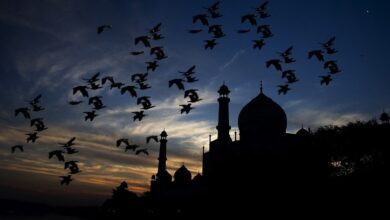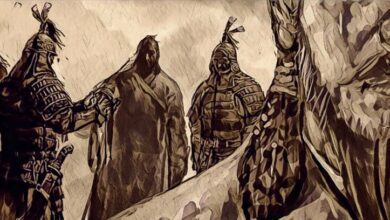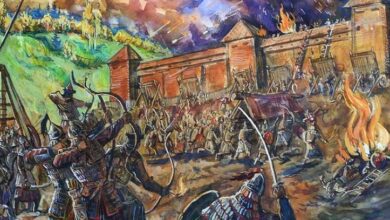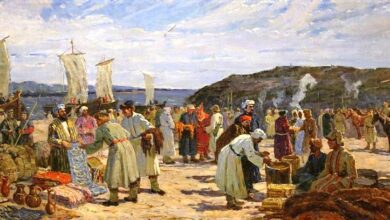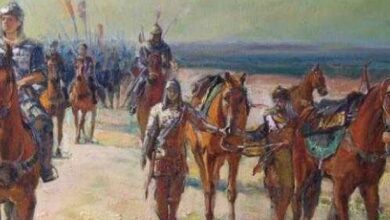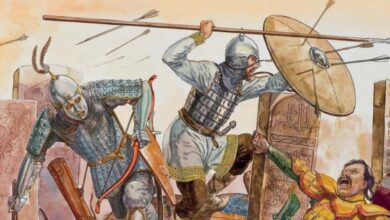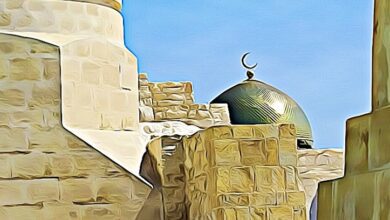
Ghazi Baraj Tarihi. Chapter 1. The most ancient history of the Bulgars
HThere is no deity other than Allah, and Mohammad is the Messenger of Allah! By the grace of the Almighty, by the will of seid Jagfar, I, his bakhshi Iman, strung on a single thread of this narrative the pearls of our Bulgarian historical legends - “Gazi-Baradj tarihi”, written from the words of the king and emir Gazi-Baradj by his tebir Gazi-Baba Khuja, “ Bu-Yurgan kitabs” by Seid Mohammedyar, “Sheikh-Gali kitabs” by Mullah Ish-Mohammed…, as well as the words and documents of the archive… Seid Jagfar, in order to preserve the memory of the deeds of our great Bulgar people… I won’t be a judge of what is described, because I didn’t see it myself but only the Almighty knows whether it was so or not.
Written by Gazi Baba. Ghazi-Baradj said.
7
Chapter 1. The most ancient history of the Bulgars
The beginning of our beginnings is in the Imen and Sind tribes. Gabdulla ibn Mikayil Bashtu wrote that the people of the Imen tribe lived in scattered families on both banks of the Amul River, which was infested with snakes, and were engaged in fishing, hunting and gathering fruits. Because of the fear of snakes, people did not dare to cross the river and fished near the shore. And only one of them - Boyan was a carrier, and the snakes did not touch him. And since he alone was a liaison between the families of both banks and was distinguished by courage and honesty, the people chose him as their leader. When Boyan grew old and, on top of everything, fell ill, his sons left him to the mercy of fate. Then he began to pray to the Almighty to send him a son to help him. The Creator threw a huge fish on the shore near his house on poles, from the left ear of which his youngest son Idjik was born in the form of a snake. After the death of Boyan, the women of the tribe began to give birth to the dead, and Idzhik, having gathered the men, withdrew with them, first to the possessions of his brother Laish, and then to the mountains of Khon. Here he became lord thanks to the courage of the Imens - excellent archers. The Kytai Turks who submitted to him ate half-baked meat and never washed in water, because they descended from the wolf Chin and tried to keep the lice characteristic of him. If the lice were very annoying, the Kytai, like wolves, killed them with their teeth. The wives and girls of the Chinese Turks freely copulated with any man, wherever possible. The Imen people could not endure the sight of this. Having taken from the Kytais several girls who had not had time to accustom themselves to the filth and fornication of their mothers, the Imenians, led by Idzhik, began to move from one Turkic settlement to another, so as not to observe the vile life of the Kytais for a long time. There were no large rivers suitable for swimming in the mountains, so the Imens walked. But it was hard, and Ijik ordered people to learn how to ride horses, such as the Chinese Turks had. For his visits, Idjik ordered to gather people and prepare refreshments and tribute. During his stay, he made appointments, judged and gave instructions. These gatherings were called jiens… In order to live among the Turks, the Imens had to learn their language…
8
When the girls grew up, the Imens, who raised them in their own way, married them and called themselves and their descendants Khons. They never approached the Kytays because of disgust, and they paid them with hatred. Fearing rebellions, Ijik took all the Turkic gunsmiths to himself, dressed his people and their horses in iron armor and forbade the Kytays to have military weapons and wear chain mail. He ordered the notorious troublemakers from this tribe to be thrown into raids on the Khin, so that they would beat the Khins instead of the Khons ...
Under the descendant of Idjik Tigan, nicknamed Khin-Batyr for numerous victories over the Khins, the oppressed Khin king sent his people to the Kytai Turks and ordered them to convey: “When your ancestors lived under our rule, you almost did not feel its burden. Now you are cruelly ruled by the small people of the Khons, and you, instead of helping us in the fight against them, are fighting for them against us. Are you smart? Destroy the Khons and return again under our blessed power!” Hearing the call of King Khin, the Kytai attacked the headquarters of Khin-Batyr at night and killed all the Khons who were in it. Khin-Batyr's wife managed to throw her son into the Dulo River in a large cauldron and was immediately surrounded by enemies. Her hands and feet were cut off, and she died in agony. Mikayil Bashtu in "Shan kyzy dastany" tells that the deer, who came to the watering place, caught the cauldron with his horns and took the boy to Semirechye. There he was sheltered and raised by the king of the Masguts Mar. He received the name Gazan, married the daughter of Mar, and began to call his clan Dulo Marduan-Dulo. Meanwhile, the Khons, who were in the other camp, had already elected a new king, Khazar. Learning about this, Ghazan, together with the Masguts, who he called Badjanaks, invaded the kingdom of Khazar. The Khons immediately went over to the side of Gazan, and Khazar fled to the Chinese Turks and became their leader. Gazan threw the Khins back across the Kuban-su River and established his banner on it - a red felt ball with multi-colored ribbons on a spear. It was a Masgut image of Alp Elbegen, a winged serpent worshiped by the Khons. The Masguts called Elbegen Baraj. The Khons, who had their own image of Elbegen, did not like this, and they demanded that Gazan replace the Masgut banner with the banner of Idjik. The king did not agree and forbade even talking about it. For 400 years, the Khons endured this humiliation and accumulated hatred for the Masguts surrounding the Dulo clan. Finally, under the descendant of Gazan Djilki, the patience of the Khons snapped and most of them joined the descendant of the Khazar Dugar, who relied on the Kytays and Turkmens. Dugar, in addition, managed to get the support of the Bashkorts, who were a mixture of Masguts and Urmi and spoke the Urmi language. Their nomad camps were located to the north of the Badjanaks and to the west of the Khon mountains. Between the Khon mountains and the Kuman desert, north of the Khin, the Kyrgyz roamed. When Dugar invaded the possession of Djilki and defeated it, some Masguts fled to the Kangly Kyrgyz. When Dugar conquered these Kyrgyz, part of them, led by Saban, went to the Badjanaks and there merged into the people of the Sabans or Badjanaks. The Sabans began to speak the Kyrgyz language, but more noble, as it was influenced by the dialect of the Masguts. The Kyrgyz speech of the Kumans, Oimeks and other descendants of the Kyrgyz, also called Kypchaks - after the Kyrgyz leader, brother of Saban, Kypchak, who obeyed Dugar - sounds rude due to the influence of the speech of the Kytai Turks. Later, the Sabans submitted to Dugar and took so much from the language of his Türkmen that some began to consider them a Türkmen tribe. And this borrowing happened as a result of the inclusion of several Turkmen clans into the Sabans ... The defeated Dzhilki was also forced to submit to Dugar. Very soon, however, unable to bear the humiliation, Djilki rebelled, but was again defeated and killed. His son Bulumar fled with the faithful Khons and Masguts to the west. Nowhere did he meet with special sympathy, for who needs a broken and poor? In addition, everyone did not like the proud Bulumar's claims to supremacy. When crossing Semirechye, most of the Masguts lagged behind the Khons...
Bulumar really wanted to stay in Semirechye, but the Turkmen tribe opposed it. These Turkmens were the descendants of some Kyrgyz and Turks who came with Saban to the land of the Masguts and gradually became stronger. They are very beautiful in appearance and speak a pleasant language. In a kindred circle, the Turkmens are very caring and kind, but outside of it, their temper is very proud and quick-tempered, and they are very unfaithful in their unions. Among other things, they did not want to obey anyone and did not really respect their elected leaders either. In Bulumar they saw a threat to their independence, and therefore began to threaten him with war. The tsar was forced to go to the Bashkorts, who sheltered the Khons and gave them the name "Sebers" ("allies"). The Bashkorts, whom the Turks called Ugyrs, were self-willed, like the Turkmens. They worshiped the alp Baraj, however, calling him Madjar. According to their beliefs, Majar was the patron of Life... Yakub, the son of Nugman, wrote that Baraj lived first on Mount Kaf, and then, when the Alps covered the earth from the sun with a wall, he flew to the Kuman desert, and then to the Bashkorts.
10
Here he was warmly welcomed by the people and hostilely by the leader of the Bashkorts, Chirmysh, who considered Lebed his ancestor and wanted the Bashkorts to worship Lebed. In the end, the biy treacherously wounded Baradj, and he flew away to the Kuman desert, cursing Chirmysh. Shortly after this, Chirmysh died in terrible agony, and the Bashkorts became convinced that the Serpent was the king of Life - Madjar, ..
When they sheltered Bulumar, Dugar tried to treacherously attack them under the cover of night. However, the cranes warned the Bashkorts about the danger with a cry, and they migrated to the west along with the Khons. But they did not walk with Bulumar for very long and lagged behind him, since they did not like the tsar's encroachment on power ... Two clans stood out among them - ura and baigul. From them, the Khons adopted the habit of pronouncing the word "kan" in the form "khakan" ...
In the country of Idel, near the river Agidel, the movement of the Khons was interrupted for a while, because there was also the state of the Khon clan Bulyar ... The last Utig ruler of Bulyar, Joke-Utig, had the imprudence to burn down the nest of Baraj in order to please his wife - Murdaska, who demanded that he build a city on this place. All the children of Baraj died in the fire, except for one, and he himself flew to another place and said goodbye to Joke-Utig: “I have always been the patron of the Khons - and I will remain so. But for your evil deed you will die from the bite of my last son, and all your children will be killed.” But this bek not only was not afraid, but, on the contrary, on the new advice of his wife, he began to search for Khin treasures in the graves of his ancestors. And when he unearthed one grave, instead of human remains, the bones of a horse appeared from the earth. It was a warning sign from Tangra, but Joke-Utig did not heed this warning and continued to dig. Then the Serpent, the son of Baraj, crawled out from under the bones and bit the bek, which caused him to die immediately ... His children began to quarrel with each other, and then, not wanting to transfer power to any one of them, they took and gave the kingdom to Bulumar ... When the kan went further, they followed him and all, except Baksu, died in the battles. Baksu, fearing the curse of Baraj, married thirty girls and had seventy sons from them. But one day in the land of the Anchians, the Galidjians attacked him and killed him along with all his sons ...
Feedlessness forced the Kan to go west. Forced to leave his headquarters in the state of Idel or Old Turan, Bulumar with his ... crossed the Agidel River, called Atil by the Bashkorts - in honor of the Masgut hero Atille or Atilkush. The local Kara-Masguts, who were also called Saklans, tried to prevent this, but were defeated and, led by their biy Boz-Urus, fled to Buri-chai. But the Bulgars, subordinate to the Kara-Masguts, joined Bulumar when he raised his native Assk banner of Baraj in the form of a red felt Ball with a bunch of multi-colored ribbons above it. And it must be said that Seid Yakub spoke about the antiquity of the Bulgar tribe in his “Kadi Kitaby”, based on the information of “Khazar Tarihi” Abdallah bine Mikayil Bashtu: “... Kamyrs are a branch of the Sindians. They were nicknamed so because they believed in a fairy tale about the manufacture by the Almighty of their foremother - Kamyr-Abi - from dough. The Kamyrs revered her so much that they gave her name to the boys. They did not tolerate the fact that the rest of the Sindians began to give the stone statues of the supreme Sindian deity - Tara or Tangra - a blasphemous appearance of a simple person, and not the pointed stone mountain Samar with smooth, even slopes, and returned from Sind to their former place of residence - to the Samar River near the mountain Samar. Their area began to be called Turan... However, when one part of the Turanians began to make sculptures of Tara from pure gold, and the other from clay, the third left them and settled in another area, named after the former habitat - Samar. They began to be called Samarans, and all the rest - Masguts ...
And the Sindians called the word "samar" the most beautiful and highest mountains, because of which the sun appeared.
Those who called the sculptures the word "tarvil" went to the west. They were also called Ases or Armans:
Along the way, some settlers weakened and were abandoned by the rest at the foot of the Kaf mountains in Azerbaijan. Then the Masguts attacked them and subjugated them for a while, turning them into their slaves. Part of the abandoned aces, unable to withstand the oppression, fled to the Saklan steppes to the north, where they received the name "cola", that is, "slaves". They were also called "as-colas".
12
And the settlers from Idel, who went farthest to the west, were called Bulgars... In the new place, they erected, first of all, a huge mountain in honor of Tara and named it and their country Samar. And this power of Kaf-Bulgars reached its heyday under the king Kamyr-Batyr. The descriptions of his life, available in the book of Abdallah's menli, are very reminiscent of the biographies of Yusuf ... But after his death, some of the Samarans polluted the water with sewage, forgetting that it was also considered sacred, because it reflected their deity Tara. The enraged deity decided to flood the entire land of Samar for this sin, but at first he warned people with a terrible voice. From this voice the earth shook and all the leaves fell from the trees. Some of the Samarans, frightened, went even further to the west and were nicknamed "Agachirs" in memory of the sign, that is, people of trees. They reached Misr, where they also lived for some time and built many mountains - Samar or Dzhuketau. Among the rest there was one kind of Samarans who did not offend the water. The Almighty took pity on him and gave him a ship to save him, and then flooded the whole of Samar. When the water subsided again by the will of Tangra, the ship remained on the top of Mount Samar, and the surviving clan, calling itself "Hay" ("New"), descended from it to earth. This family gradually became numerous and began to worship both the mountain and the ship. But part of him once rebelled and dragged the ship down, believing that no thing should be on Dzhuketau - the sacred prayer mountain.
And inside this and other mountains of Samar they made a cave where they put the dead people. And if the husband died, then his wife was walled up alive in a cave with him, and if the wife who won the wedding duel from her husband died, then her husband was walled up alive in the cave along with her body.
When the ship was dragged from the mountain, the majority of Samara residents condemned the perpetrators of this to exile. Then the convicts boarded this ship and, having crossed the Saklan Sea, settled in Dzhalda and the steppes adjacent to it. And the noble grunt Targiz or Tarsiz dominated them ...
The settlers, who were called "Kimers" - a distorted word "Kamyrs", began to worship him after his death. And in memory of him, they say, at the time the jiena jumped over swords stuck in the ground with the tip up.
Then the Idel Bulgars came here and expelled some, and subjugated the other Chimerians for the past offense ... Part of the Bulgars, together with the Kipchaks subject to Idel, set off to pursue the fleeing Chimerians and, finding the Masguts there, began to beat them too.
Then, having returned, the Bulgars discovered that the Kipchaks settled in Saklan mixed with the Kimmerians and began to worship Targiz.
Then they expelled them for this to the rivers Deber and Shir. And from the Bulgars who went to Samar came the Uruses, and from the Shir Targiz people - the Murdases...
And the Agachirs were expelled from Misr by the Arabs and went to the Saklan steppe... But here they were unfriendly met by the stakes, who turned them into their slaves... And the Ases who remained in Samara, called the As Bulgars, also, in the end, went to Yana Idel, to Lake Kaban and to Azerbaijan, where they reunited with the local Turkic Bulgars ... Then the Persians resettled a thousand Turks of Jan Idel, of whom Arman was a part, to Khorasan ...
Then a part of the Masguts came from Turan, who left the rest for the steppe Tang-Alan (“Stone Glade”) and therefore received the nickname “alan” (“glade”). And ours, having spoiled "Tang" in "Sak", began to call them Saklans. And these Saklans, having attached to themselves the Murdas and Agachirs, defeated their enemies - the stakes and took possession of the steppe of the vanquished ... And they were also called Kara-Masguts, in contrast to their relatives - the Ak-Masguts, who remained in Turkistan. And the steppe of the Kypchaks, stretching from Sula to Agidel, began to be called Saklan ..., and all the descendants of the Ases who lived in it - Saklans or Alans ...
Later, the Almanians of the Galidzh tribe came to Buri-chai from Sadum and pushed out the Saklans, who were called "Urus" after the leader Urus. And they pressed it because the Saklans started a war with a part of the Bulgars who moved from Azerbaijan to Burdzhan... And these Bulgars immediately joined the Khons when they crossed the Idel...
Urus tried to drive the Sadumians off the banks of Buri-chai, but was defeated and killed. Then the Saklans-Uruses submit to the Khons and persuade Bulumar to attack the Galidjians.


